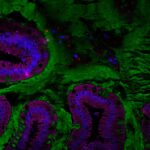Lien vers Pubmed [PMID] – 28219893
Lien DOI – 10.1136/gutjnl-2016-313510
Gut 2018 May; 67(5): 860-871
Clostridium difficile is a toxin-producing bacterium and a leading cause of antibiotic-associated disease. The ability of C. difficile to form spores and infect antibiotic-treated persons at low multiplicity of infection (MOI) underlies its large disease burden. However, C. difficile-induced disease might also result from long-harboured C. difficile that blooms in individuals administered antibiotics.Mice purchased from multiple vendors and repeatedly testing negative for this pathogen by quantitative PCR bloomed C. difficile following antibiotic treatment. This endogenous C. difficile strain, herein termed LEM1, which formed spores and produced toxin, was compared with highly pathogenic C. difficile strain VPI10463.Whole-genome sequencing revealed that LEM1 and VPI10463 shared 95% of their genes, including all known virulence genes. In contrast to VPI10463, LEM1 did not induce overt disease when administered to antibiotic-treated or germ-free mice, even at high doses. Rather, blooms of LEM1 correlated with survival following VPI10463 inoculation, and exogenous administration of LEM1 before or shortly following VPI10463 inoculation prevented C. difficile-induced death. Accordingly, despite similar growth properties in vitro, LEM1 strongly outcompeted VPI10463 in mice even at 100-fold lower inocula.These results highlight the difficulty of determining whether individual cases of C. difficile infection resulted from a bloom of endogenous C. difficile or a new exposure to this pathogen. In addition to impacting the design of studies using mouse models of C. difficile-induced disease, this study identified, isolated and characterised an endogenous murine spore-forming C. difficile strain able to decrease colonisation, associated disease and death induced by a pathogenic C. difficile strain.


